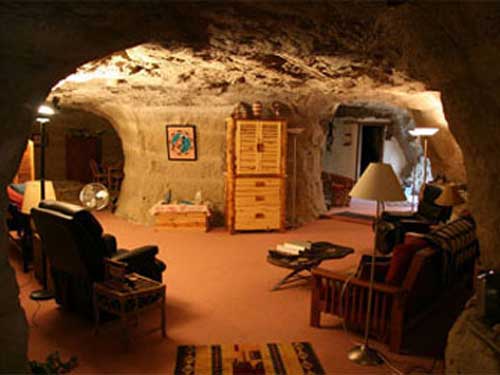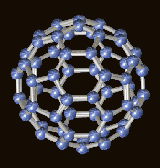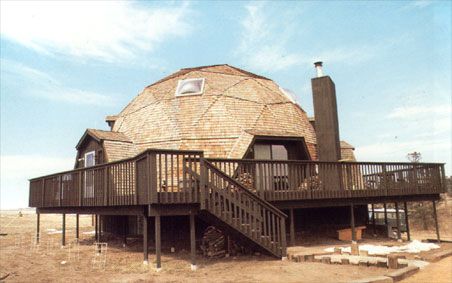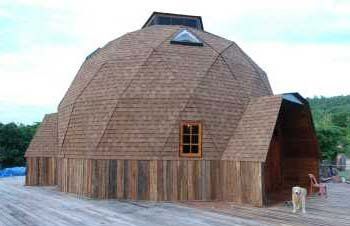You are using an out of date browser. It may not display this or other websites correctly.
You should upgrade or use an alternative browser.
You should upgrade or use an alternative browser.
is there a perfect architectural shape
- Thread starter river
- Start date
Perfect in what way? Esoterically?
To a building engineer I suppose it would have to be a box of any dimensions, bricks, planks, sheets, beams, etc....
For someone metaphysically harmonious, it would have to be something curved, preferably in black.
To a building engineer I suppose it would have to be a box of any dimensions, bricks, planks, sheets, beams, etc....
For someone metaphysically harmonious, it would have to be something curved, preferably in black.
Perfection depends on the purpose, no? If you want to save material, the geodesic dome is pretty good; if you want long straight walls for internal fixtures, a rectangle would be better; if you want to inspire awe, something tall and graceful; if fear, something squat and massive; if comfort, something with soft curves.
This is pretty cool [video=youtube;A-cfB6xFSKM]http://www.youtube.com/watch?v=A-cfB6xFSKM&feature=related[/video]
This is pretty cool [video=youtube;A-cfB6xFSKM]http://www.youtube.com/watch?v=A-cfB6xFSKM&feature=related[/video]
There are some that would be called perfect for they were made from materials that were all found around where the abodes were made and some abodes were movable to be able to relocate to a new area. The thing that is similar with them is that they are rounded in shape to allow wind to easily pass around them .



And then a cave dwelling which is really the best of them all for it remains about the same temperature without and electricity all year round.




And then a cave dwelling which is really the best of them all for it remains about the same temperature without and electricity all year round.

Yes. - Hard to beat the "Bucky* sphere" section, which can scale to any size, cover an entire city which excludes air pollution sources, etc. if desired. Least material used for covered area with no internal posts, etc. Very efficient if set on ~7 foot high section of thin concrete wall** cylinder (that has steel hoop for the outward stress) as the humans can stand anywhere inside the enclosed space. Sheds rain, snow or wind well. This one covers 5.1 acres and gets a lot of snow as is "Superior Dome Stadium" of Northern Michigan Univ. at Marquette, Michigan, USA, 160 m (525 ft diameter. I´m not sure if that is the Bucky ball diameter or be the base on earth diameter. But as it overs the 5.1 acres, you could determine which, if not as lazy as I am.) I think the more conventional pointed roof at top dead center prevents snow and ice build up where dome´s surface is horizontal, and helps make window controlled draft for natural, no energy use, ventilation. Note the fresh air entry vents, just above the tree tops, have sharp tops too. That is tiny part of northern Lake Michigan in photo foreground. I bet in dead of winter you can drive your car on the ice along the shore line.

*Invented by Mathematician & Architect Buckminster Fuller - See wiki for more. Nature likes / uses Bucky Fullerenes too. Here is structure of a 60 carbon one:
 The 2D versions we call "nano tubes." **Wall a ring only for top foot or so - inverted U openings for least concrete and access.
The 2D versions we call "nano tubes." **Wall a ring only for top foot or so - inverted U openings for least concrete and access.
*Invented by Mathematician & Architect Buckminster Fuller - See wiki for more. Nature likes / uses Bucky Fullerenes too. Here is structure of a 60 carbon one:

Last edited by a moderator:
Hard to beat the "Bucky* sphere" section, which can scale to any size, cover an entire city which excludes air pollution sources, etc. if desired. Least material used for covered area with no internal posts, etc. Very efficient if set on ~7 foot high section of thin concrete wall cylinder (that has steel hoop for the outward stress) as the humans can stand anywhere inside the enclosed space. Sheds rain, snow or wind well. This one covers 5.1 acres and gets a lot of snow as is "Superior Dome Stadium" of Northern Michigan Univ. at Marquette, Michigan, USA, 160 m (525 ft) diameter. (I´m not sure if that is the bucky ball diameter or be the base on earth diameter. But as it overs the 5.1 acres, you could determine which, if not as lazy as I am.) I think the more conventional pointed roof at top dead center prevents snow and ice build up where dome´s surface is horizontal, and helps make window controlled draft for natural, no energy use, ventilation. Note the fresh air entry vents, just above the tree tops, have sharp tops too. that is tiny par of Lake Michigan in photo foreground. I bet in dead of winter you can drive your car on the ice along the shore line.

*Invented by Mathematician & Architect Buckminster Fuller - See wiki for more.
I believe you are referring to geodesic buildings. I like this dome beach house.

But this one looks like it has some great amenities.

This one is cool because the first floor has vertical walls.

When I lived in California many years ago I thought about building a dome home. Even visited a guy that built his own dome home. The master bedroom was an open second floor loft and he had triangular windows arranged in a pattern from floor to top of the roof. It was only a 30 foot dome, so there was not a lot of space. I was thinking a 45 footer would have been cool, but never got around to doing it.
In 6th grade I remember a teacher who asked us this. His answer I won't forget. He said the X. It is used in bridges. An supports a lot of weight. Also you can find it in many other places. But its the X.
I tend to agree. Even this image from above http://www.nanotech-now.com/images/buckyball2-sm.gif has the X shape in it.
I tend to agree. Even this image from above http://www.nanotech-now.com/images/buckyball2-sm.gif has the X shape in it.
That is same image I gave at end of my post 6, but it has no Xs. It has open sided triangles or Ys. Look again. Sometimes the open Ys are closed (to have the 3 sides of an triangle) to inscribe an equilateral triangle. In some cases, but not as described by Buckminster Fuller, that same "ball" structure is ONLY the hexagons. The adjoining hexagon ball (with some squares?) is the official form of a football (soccer ball to Americans) now.... this image from above http://www.nanotech-now.com/images/buckyball2-sm.gif has the X shape in it.
I'd say the triangle. When you have a rectangle, it is unstable and can deform from in plane forces while not changing its lengths, only angles. It can collapse. When you place a diagonal in the rectangle, it is stable and cannot collapse except by over stress of the individual components.
That is same image I gave at end of my post 6, but it has no Xs. It has open sided triangles or Ys. Look again. Sometimes the open Ys are closed (to have the 3 sides of an triangle) to inscribe an equilateral triangle. In some cases, but not as described by Buckminster Fuller, that same "ball" structure is ONLY the hexagons. The adjoining hexagon ball (with some squares?) is the official form of a football (soccer ball to Americans) now.
You know what they say about a picture.

Thanks. I knew that the ball could not be all hexagons as they fill a plane.* So I added "(with some squares?)" but as your photo shows, pentagons are what is needed to curve it into a ball.You know what they say about a picture. ...[/IMG]
* There is a relative small set of shapes with straight line sides that will "fill" a plane. Obviously equilateral angles, squares, or regular hexigons (including clever distortion of them like Etcher made) will but there a few more with straight (but not equal length)* sides. The head of APL´s space department found a new one only about 30 years ago.
*Rectangles will, but I think they are considered to be "distortions" of the square by topologists, not really a new "plane filler."
So I saw the picture wrong. I still say the X is the perfect architectural shape.
R1D2,
Might you have some examples of X to share? I'd like to know more about your X reasons,Thanks Tim....
Well I still think the X. Is the shape I have used it before in welding. An I have seen it in structures. Basically a triangle shape with one upside down on top. A hourglass form if used right can be very strong.
Even though this information I am adding is not a X shape it to is strong.
http://www.teachersdomain.org/assets/wgbh/phy03/phy03_img_lpastraw/phy03_img_lpastraw.gif
And this will give you plenty to try. An plenty to see.
http://blogs.asee.org/goengineering/wp-content/uploads/2008/12/291e_exit5.jpg
http://teachers.egfi-k12.org/lesson-design-and-build-a-road-sign-support/
Even though this information I am adding is not a X shape it to is strong.
http://www.teachersdomain.org/assets/wgbh/phy03/phy03_img_lpastraw/phy03_img_lpastraw.gif
And this will give you plenty to try. An plenty to see.
http://blogs.asee.org/goengineering/wp-content/uploads/2008/12/291e_exit5.jpg
http://teachers.egfi-k12.org/lesson-design-and-build-a-road-sign-support/
No an X is not even one triangle. Triangles have 3 sides, two triangle would need 6 side an X has either 2 or 4 if both equal length parts of the straight sections are counted separately. Another property of all triangles that the X does not have is a triangle divides the plane into two distinct regions -the inside and the outside.An X is two triangles, so maybe twice as good. I like the arch, but think the triangle beats it for efficiency.
This is not to say that Xs are not used in construction - they are. If placed inside a square (or rectangle) they help it keep its shape but a single diagonal bar does that also at half the cost. Costwise twice better than the X.
The X shape is used in construction as "X bracing" , often seen on the outside of tube type buildings, but in these cases, the X has a top and a bottom which is normally a floor or spandrel beam.
This is what makes the X stable, it is composed of 4 triangles. The X by itself is unstable.
This is what makes the X stable, it is composed of 4 triangles. The X by itself is unstable.
spidergoat
Valued Senior Member
Yes, the rectangle.
